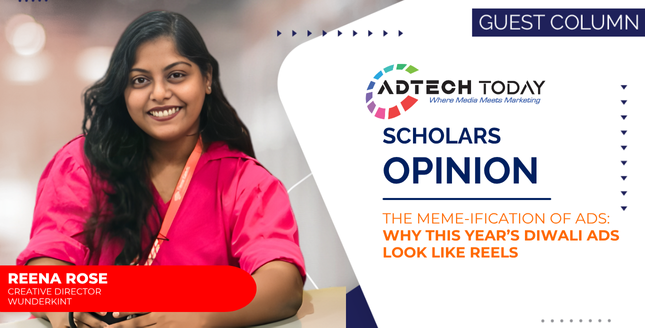
There’s a new creative language taking over Indian advertising this festive season: meme logic.
It’s the grammar of the scroll, short, sharp, emotionally charged, and effortlessly native to the feed. Ads no longer speak to people; they blend into the way audiences already consume, share, and joke. The result? This Diwali, the country’s biggest campaigns don’t look like commercials anymore. They look like Reels.
For years, the festive brief meant one glossy hero film, a long emotional arc, and a multi-crore media burst. Today, it’s a different battlefield – scroll culture. The ad has exactly three seconds to earn attention, empathy, and recall.
Industry has shifted from a single big story to a system of short, vertical stories designed for different contexts and screens. The creative rulebook is simple: Hook fast. Land the heart. Leave a memory cue.
When writing, treat the first three seconds as if that’s the entire ad because often, that’s all people will see. Each asset has one job: show a benefit, demonstrate a use case, or deliver an offer. Not everything at once.
Design choices follow this logic too: sound-off captions, tight framing, visible headlines, and modular structures that can flex from a 6-second Reel to a 40-second CTV cut. Measurement has evolved accordingly: we track hook-hold (first 2–3 seconds), saves, shares, and quality comments, not just completion rates.
Brands like Cadbury Celebrations and Tanishq have mastered this modular storytelling. Cadbury’s films open with a punchy reveal, then slip seamlessly into an intimate beat that can be sliced vertically for Reels without losing emotion. Tanishq’s cinematic anchors become micro-edits for different audiences and price tiers, proving that emotion and efficiency can coexist. Meanwhile, Meesho demonstrates how creator-style edits, quick outfit switches, price pops, and one clear CTA often outperform longer, layered narratives.
AI isn’t replacing the creative instinct, it’s amplifying it. In any workflow, AI acts as a creative and production assistant, helping to listen, move, and personalise faster.
Listening first: AI tools help cluster thousands of festive comments, reviews, and search cues to surface real anxieties, same-day gifting, return safety, and pet-friendly diyas. That insight becomes the emotional spark for the next batch of creatives.
Then comes speed: AI now generates multiple safe variations of openers, captions, thumbnails, and even voiceovers. During Diwali week, that means we can A/B/C test ideas daily without re-shooting.
Finally, there’s personalisation at scale, local voice-overs, text swaps, or visual tweaks all within brand safety and consent protocols. Human judgment still anchors taste, tone, and culture. Done right, AI reduces the cost of creative iteration while giving teams more “shots on goal.”
Brands are already living this future. Cadbury’s “Not Just a Cadbury Ad” showed how tech can personalise festive messages for small businesses without losing intimacy. Nykaa uses AI-assisted asset versioning to keep its GRWM stories fresh across categories, and Blinkit deploys rapid, AI-aided copy and templated design for real-time festive demand spikes, showing that speed and safety can coexist.
If Diwali storytelling once chased cinematic perfection, today it chases credible proximity. A creator filming in their living room feels like a recommendation; a slick monologue feels like a sell.
“UGC tone” isn’t about being unpolished; it’s about being believable. The camera language shifts to handheld, natural light, balcony diyas, kitchen mithai prep, the real chaos of home. The structure compresses to show-and-tell: unbox, try, react. Captions, comment overlays, and Hinglish voice add conversational rhythm.
Authenticity doesn’t mean ignoring regulation. Disclosures like #Ad or “Paid Partnership” are now part of good design. In fact, transparency builds trust.
Lo-fi, however, is not off-brand. Brands still follow their colourways, typography, and pack-hero rules to ensure consistency. The goal is to feel native to the feed yet unmistakably “us.”
Look at Asian Paints, which continues to capture the spirit of real homes while staying emotional and premium. Amazon works with mid-sized creators for bite-sized deal demos that sound like genuine recommendations. boAt uses lo-fi unboxings and snappy copy to sound creator-native yet retain its distinctive energy. The creative sweet spot is somewhere between authenticity and authorship.
The festive shift has forced agencies to evolve from production powerhouses to creative operations systems. We still make hero films, but now we resource the ecosystem around them.
Important to plan in sprints:
Creator partnerships are treated like media inventory, with planned flighting, frequency, and refresh cycles. Whitelisting and reposts are not improvisations; they’re strategy.
Measurement ties it all together. Metrics such as brand search lift, share/save rate, product page views, add-to-carts, and coupon redemptions all ladder into a unified taxonomy so creative credit doesn’t vanish across social, CTV, and retail media.
Budgeting follows the same logic, a 70/20/10 split:
Light brand guardrails keep this dynamic system coherent: a tone-of-voice sheet, simple visual rules for lo-fi capture, and a disclosure checklist crucial for regulated sectors.
The meme-ification of ads isn’t about making jokes. It’s about thinking in memes: self-aware, fast-moving, emotionally resonant, and endlessly remixable.
When you design for the feed, you design for participation, not just persuasion. The real win is when your story gets duetted, stitched, spoofed, or referenced when your brand becomes part of a cultural rhythm instead of an interruption.
That’s what this festive season is showing us: the line between ads and entertainment is blurring, but not because craft has died. It’s because craft has adapted to smaller screens, shorter spans, and a smarter audience that values wit over wallpaper.